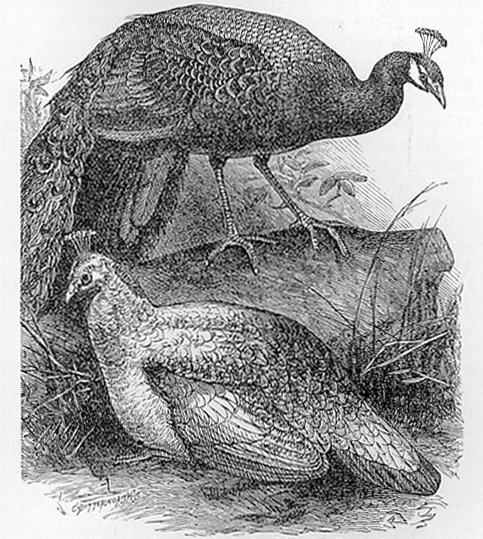1902 Encyclopedia > Peacock
Peacock
PEACOCK (the first syllable from the Latin Pavo, in Anglo-Saxon Pawe, Dutch Pauuw, German Pfau, French Paon), the bird so well known from the splendid plumage of the male, and as the proverbial personification of pride. A native of the Indian peninsula and Ceylon, in some parts of which it is very abundant, its domestication dates from times so remote that nothing can be positively stated on that score. Setting aside its importation to Palestine by Solomon (1 Kings x 22; 2 Chron. Ix 21), its assignment in classical mythology as the favorite bird of Hera or Juno testifies to the early acquaintance the Greeks must have had with it; but, though it is mentioned by Aristophanes and other older writers, their knowledge of it was probably very slight until after the conquests of Alexander. Throughout all succeeding time, however, it has never very freely rendered itself to domestication, and, retaining much of its wild character, can hardly be accounted an inhabitant of the poultry-yard, but rather an ornamental denizen of the pleasure-ground or shrubbery; while, even in this condition, it is seldom kept in large numbers, of it has a bad reputation for doing mischief in gardens, it is not very prolific, and, though in earlier days highly esteemed for the table, it is no longer considered the delicacy it was once thought.

"Japanned" or "black-shouldered" Peafowls
As in most cases of domestic animals, pied or white varieties of the ordinary Peacock, Pavo cristatus, are not unfrequently to be seen; and, though lacking in proportion the gorgeous resplendence for which the common bird stands unsurpassed, they are valued as curiosities. Greater interest, however, attends what is known as the "japanned" Peacock, often erroneously named the Japanese or Japan Peacock, a form which has received the name of P. nigripennis, as though it were a distinct species. In this form the cock, besides other less conspicuous differences, has all the upper wing-coverts of a deep lustrous blue instead of being mottled with brown and white, while the then is of a more or less grayish-white, deeply tinged with dull yellowish-brown near the base of the neck and shoulders. It "breed true"; but occasionally a presumably pure stock of birds of the usual coloration throws out one or more having the "japanned" plumage, leading to the conclusion that the latter may be due to "reversion to a primordial and otherwise extinct condition of the species", and it is to be observed that the "japanned" male has in the coloration of the parts mentioned no little resemblance to that of the second indubitably good species, the P. muticus (or P. spicifer of some writers) of Burma and Java, though the character of the latter’s crest-the feathers of which are barbed along their whole length instead of a the tip only-and its golden-green neck and breast furnish a ready means of distinction. The late Sir R. heron was confident that the "japanned" bread had arisen in England within his memory, and Darwin (Anim and Plants under Domestication, i.pp 290-292) was inclined to believe it only a variety; but its abrupt appearance, which rests on indisputable evidence, is most suggestive in the light that it may one day throw on the question of evolution as exhibited in the origin of "species". It should be stated that the "japanned" bird is not known to exist anywhere as a wild race. The accompanying woodcut is copied from a plate drawn by Mr Wolf, given in Mr Elliot’s Monograph of the Phasianidae.
The Peafowls belong to the group Gallinae, from the normal members of which they do not materially differ in structure; and, though by some systematists they are raised dto the rank of a Family, Pavobidae, most are content to regard them as a Subfamily of Phasianidae (PHEASANT, q.v.). Akin to the genus Pavo is Polyplectrum, of which the males are armed with two or more spurs on each leg, and near them is generally placed the genus Argusianus, containing the Argus-Pheasants, remarkable for their wonderfully ocellated plumage, and the extraordinary length of the secondary quills of their wings, as well as of the tail-feathers. It must always be remembered that the so-called "tail" of the Peacock is formed not by the rectrices or true tail-feathers, but by the singular development of the tail-coverts, a fact of which any one may be satisfied by looking at the bird when these magnificent plumes are erected and expanded in disk-like form as is his habit when displaying his beauty to his mates. (A. N.)
The above article was written by: Alfred Newton, M.A., F.R.S.; Professor of Zoology and Comparative Anatomy, University of Cambridge; late Chairman of Brit. Assoc. Migration of Birds Committee; President of the Cambridge Philosophical Society; author of Ornithology of Iceland and A Dictionary of Birds; edited The Ibis, 1865-70 and The Zoological Record, 1870-72.
|
